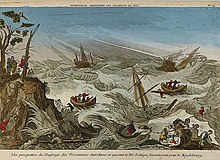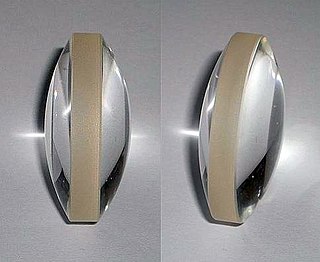
A lens is a transmissive optical device that focuses or disperses a light beam by means of refraction. A simple lens consists of a single piece of transparent material, while a compound lens consists of several simple lenses (elements), usually arranged along a common axis. Lenses are made from materials such as glass or plastic and are ground, polished, or molded to the required shape. A lens can focus light to form an image, unlike a prism, which refracts light without focusing. Devices that similarly focus or disperse waves and radiation other than visible light are also called "lenses", such as microwave lenses, electron lenses, acoustic lenses, or explosive lenses.
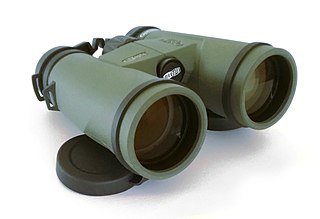
Binoculars or field glasses are two refracting telescopes mounted side-by-side and aligned to point in the same direction, allowing the viewer to use both eyes when viewing distant objects. Most binoculars are sized to be held using both hands, although sizes vary widely from opera glasses to large pedestal-mounted military models.
In photography and cinematography, a normal lens is a lens that reproduces a field of view that appears "natural" to a human observer. In contrast, depth compression and expansion with shorter or longer focal lengths introduces noticeable, and sometimes disturbing, distortion.

In photography and cinematography, a wide-angle lens refers to a lens whose focal length is substantially smaller than the focal length of a normal lens for a given film plane. This type of lens allows more of the scene to be included in the photograph, which is useful in architectural, interior, and landscape photography where the photographer may not be able to move farther from the scene to photograph it.

Stereoscopy is a technique for creating or enhancing the illusion of depth in an image by means of stereopsis for binocular vision. The word stereoscopy derives from Greek στερεός (stereos) 'firm, solid', and σκοπέω (skopeō) 'to look, to see'. Any stereoscopic image is called a stereogram. Originally, stereogram referred to a pair of stereo images which could be viewed using a stereoscope.

Depth perception is the ability to perceive distance to objects in the world using the visual system and visual perception. It is a major factor in perceiving the world in three dimensions. Depth perception happens primarily due to stereopsis and accommodation of the eye.

A stereoscope is a device for viewing a stereoscopic pair of separate images, depicting left-eye and right-eye views of the same scene, as a single three-dimensional image.

An autostereogram is a two-dimensional (2D) image that can create the optical illusion of a three-dimensional (3D) scene. Autostereograms use only one image to accomplish the effect while normal stereograms require two. The 3D scene in an autostereogram is often unrecognizable until it is viewed properly, unlike typical stereograms. Viewing any kind of stereogram properly may cause the viewer to experience vergence-accommodation conflict.

A magnifying glass is a convex lens that is used to produce a magnified image of an object. The lens is usually mounted in a frame with a handle. A magnifying glass can be used to focus light, such as to concentrate the sun's radiation to create a hot spot at the focus for fire starting.
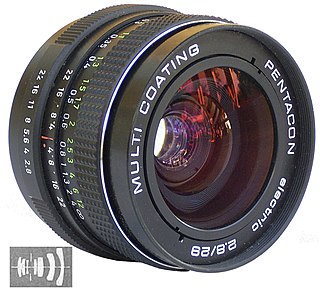
In film and photography, a prime lens is a fixed focal length photographic lens, typically with a maximum aperture from f2.8 to f1.2. The term can also mean the primary lens in a combination lens system. Confusion between these two meanings can occur without clarifying context. Alternate terms, such as primary focal length, fixed focal length, or FFL are sometimes used to avoid ambiguity.

A 3D display is a display device capable of conveying depth to the viewer. Many 3D displays are stereoscopic displays, which produce a basic 3D effect by means of stereopsis, but can cause eye strain and visual fatigue. Newer 3D displays such as holographic and light field displays produce a more realistic 3D effect by combining stereopsis and accurate focal length for the displayed content. Newer 3D displays in this manner cause less visual fatigue than classical stereoscopic displays.

A pseudoscope is a binocular optical instrument that reverses depth perception. It is used to study human stereoscopic perception. Objects viewed through it appear inside out, for example: a box on a floor would appear as a box-shaped hole in the floor.
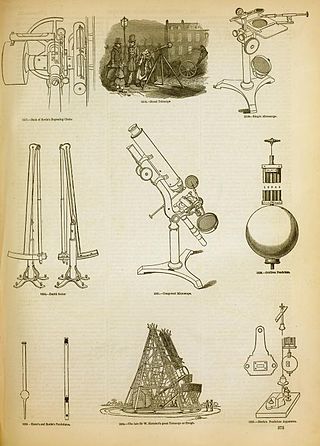
An optical instrument is a device that processes light waves, either to enhance an image for viewing or to analyze and determine their characteristic properties. Common examples include periscopes, microscopes, telescopes, and cameras.

A raree show, peep show or peep box is an exhibition of pictures or objects, viewed through a small hole or magnifying glass. In 17th and 18th century Europe, it was a popular form of entertainment provided by wandering showmen.
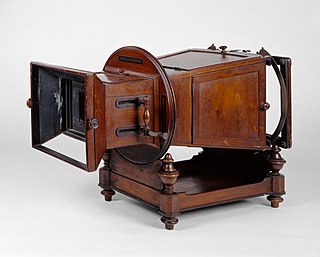
The megalethoscope is a larger version (mega-) of the alethoscope, which it largely superseded, and both are instruments for viewing single photographs with a lens to enlarge and to create some illusion of three-dimensionality. They were used to view photographic albumen prints that were coloured, perforated and mounted on a curved frame. Night effects were achieved when viewing pictures in transmitted light from a fitted oil or kerosine lamp and a daytime version of the same scene was seen when lit by the reflected light from two side mirrors. They are sophisticated versions of the peep show, and were designed by Carlo Ponti of Venice before 1862. Lke the similar graphoscope which descends from the eighteenth century zograscope predating photography, these devices were, and are, often confused with the stereoscope which was of a different design and effect. Improvements to the megalethoscope over the alethoscope, mainly the addition of a compound lens, are detailed in The Practical Mechanic's Journal of 1867.

Autostereoscopy is any method of displaying stereoscopic images without the use of special headgear, glasses, something that affects vision, or anything for eyes on the part of the viewer. Because headgear is not required, it is also called "glasses-free 3D" or "glassesless 3D". There are two broad approaches currently used to accommodate motion parallax and wider viewing angles: eye-tracking, and multiple views so that the display does not need to sense where the viewer's eyes are located. Examples of autostereoscopic displays technology include lenticular lens, parallax barrier, and may include Integral imaging, but notably do not include volumetric display or holographic displays.
Parallax scanning depth enhancing imaging methods rely on discrete parallax differences between depth planes in a scene. The differences are caused by a parallax scan. When properly balanced (tuned) and displayed, the discrete parallax differences are perceived by the brain as depth.
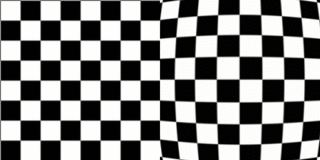
The globe effect, sometimes called the rolling ball effect or the spinning globe effect, is an optical phenomenon—perhaps partially an optical illusion—that occurs with visual optical instruments, in particular binoculars and telescopes, that are designed to be free of distortion. When these instruments are panned, the moving image appears to roll over a curved, convex surface. In 1949, Horst Koehler at Zeiss (Jena) suggested adding some pincushion distortion to the optical design to eliminate the globe effect. August Sonnefeld conducted experiments with volunteers, which supported the claim that a supplementary distortion could improve the imaging of visual optical instruments. Since that time, most binocular manufacturers have followed Zeiss's example and added pincushion distortion to their optical design.
Vue d'optique (French), vue perspective or perspective view refers to a genre of etching popular during the second half of the 18th century and into the 19th. Vues d'optique were specifically developed to provide the illusion of depth when viewed through a zograscope, also known as an "optical diagonal machine" or viewers with similar functions.

In Japanese art, a megane-e is a print designed using graphical perspective techniques and viewed through a convex lens to produce a three-dimensional effect. The term derives from the French vue d'optique. The device used to view them was called an Oranda megane or nozoki megane, and the pictures were also known as karakuri-e.

